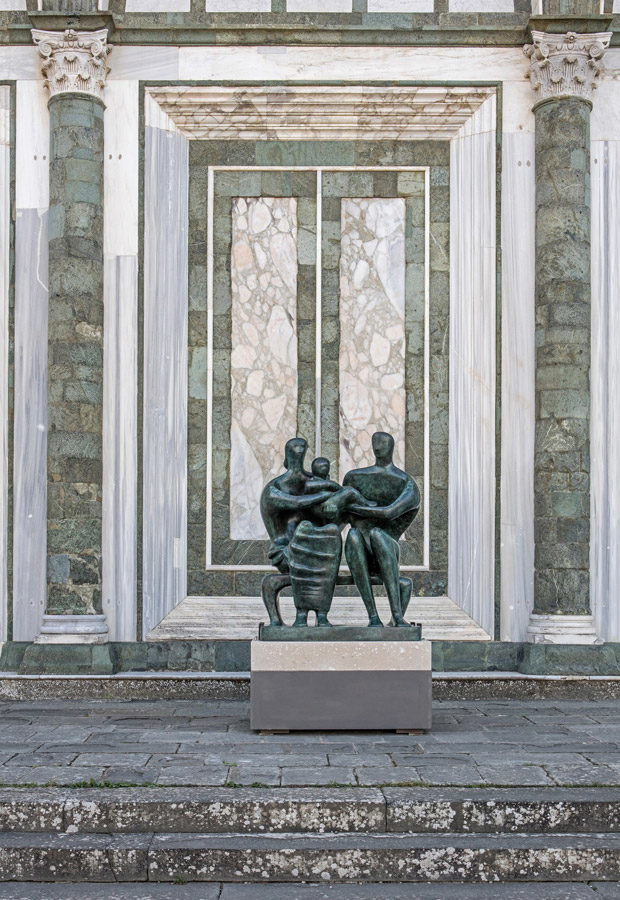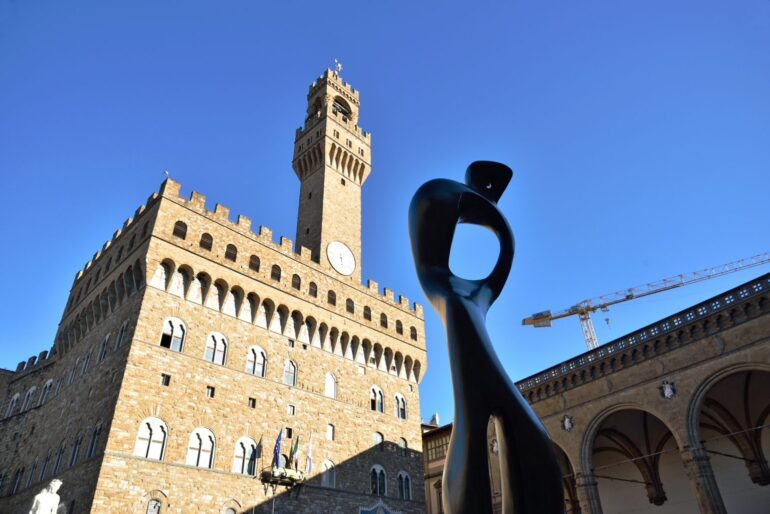A Monumental Homage
Henry Moore (1898-1986) maintained a unique relationship with Florence throughout his long artistic career. In 2022, to commemorate his landmark 1972 Florence exhibit, the city of Florence mounted two exhibits: Henry Moore in Florence (September 16 – March 31) and its companion exhibit Back to Moore: Fort Belvedere 1972 (September 22 – October 3).
Born into a mining family in West Yorkshire (UK), Moore discerned his artistic vocation early in life. His ambitions were interrupted by military service in the First World War. Moore fought in the trenches and was injured, finishing his service as a military instructor. These formative experiences marked his artistic sensibility and humanistic perspective for the rest of his life. The images of war and the emotions surrounding violence, loss, and grief stayed with him – as well as the pacifist opposites of humanity, harmony, and love.
In 1924, Moore was awarded a prestigious scholarship to study art in Northern Italy. He traveled to Europe – at a time interwar peace – and regarded the works of the Old Masters in person, Michelangelo in particular. He spent significant time in Florence to study the masterpieces tucked into virtually every corner of the city.
A sculptor at his core, sensing concrete form in lines and space, the idealized and abstract bronze sculptures that he came to create speak to our common human experiences and yearnings.
Family Group – Sagrato dell’Abbazia di San Miniato al Monte

Family Group was Moore’s first large-scale bronze sculpture, cast in 1950-1951, after ideating the piece for years in drawing and smaller models. The piece offers a familiar representation of the Holy Family (Mary, Jesus, and Joseph) in a secularized, humanistic approach, carefully placed in the sacred space of San Miniato. A mother holds a child with a father close by. The energy of the sculpture pulls the viewer into the literal heart of the figures: the woman looks down, the man’s knees point in. Their sacrifice is evident. Here is their child, to be cherished and protected. The child is the future. Moore’s memories of wartime trenches inform the Family Group, urging mankind to put down our weapons: there is another way, a peaceful way. The quiet energy of the sculpture encourages meditation on options and choices when we are presented with conflict and sacrifice. What is the future really, and where and how do we meet it?
Large Interior Form – Piazza della Signoria

Large Interior Form was created subsequent to Family Group, cast in bronze later in the decade, and continues the artist’s discourse on form and space, gravity and levity, humans and nature. The eye is drawn upward with the figure, then down again. The arms create a hole, a space, that functions as a sort of lens through which to view the world: the human embrace. In this piece again we see how Moore did not pursue a realistic human form based on anatomy, but rather an idealized form that feels dreamlike and Jungian, concrete and relatable. In contrast to Family Group, Large Interior Form is on display in a secular space in the Piazza della Signoria, as bustling a locale as San Miniato is serene. The questions posed by Large Interior Form are not communal, but individual. How should we relate to the world around us? Can we be rooted as we reach? Can we make space as we take space?
Back to Moore: Fort Belvedere 1972 – Palazzo Vecchio

The companion exhibit Back to Moore: Fort Belvedere 1972 will be on display from September 22 to October 3, and features images of the landmark 1972 Moore show at the Forte Belvedere of Florence. Moore felt this show was the crowning achievement of his career, and spent hours personally curating and working on the 1972 show. Its memory lives on in Florence today, and the images were gathered in a public call through local newspapers and social media channels. One hundred eyewitnesses to the 1972 exhibit were selected, and their images are featured in the Palazzo Vecchio in the spirit of collective art.
Both Henry Moore sculptures are on display outdoors and free of charge for public viewing from September 16 to March 31. See Large Interior Form in Piazza della Signoria, and Family Group at the Abbey of San Miniato al Monte.
From September 22 to October 3, the companion exhibit Back to Moore: Forte Belvedere 1972 will display historic images collected from visitors to the landmark 1972 exhibit. See Back to Moore in the Sala d’Arme of the Palazzo Vecchio in Florence.









